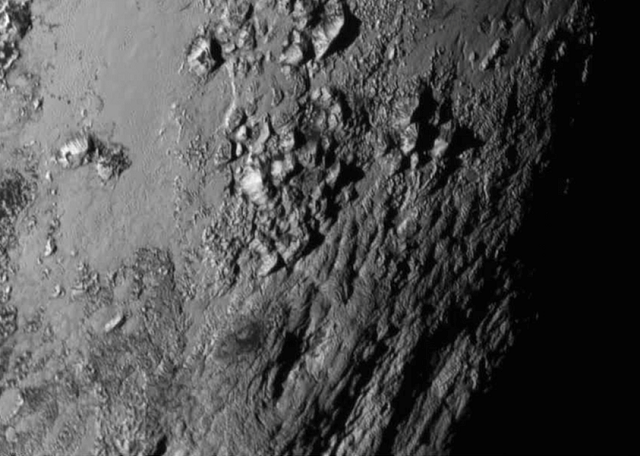 New close-up images of a region near Pluto’s equator reveal a giant surprise -- a range of youthful mountains rising as high as 11,000 feet (3,500 meters) above the surface of the icy body. Credits: NASA/JHU APL/SwRI
New close-up images of a region near Pluto’s equator reveal a giant surprise -- a range of youthful mountains rising as high as 11,000 feet (3,500 meters) above the surface of the icy body. Credits: NASA/JHU APL/SwRI
NASA’s New Horizons team have announced a series of discoveries including a new, vivid view of Pluto’s largest moon, Charon and the icy mountains on Pluto just one day after the spacecraft’s first ever flyby.
"Pluto New Horizons is a true mission of exploration showing us why basic scientific research is so important," said John Grunsfeld, associate administrator for NASA's Science Mission Directorate in Washington.
"The mission has had nine years to build expectations about what we would see during closest approach to Pluto and Charon. Today, we get the first sampling of the scientific treasure collected during those critical moments, and I can tell you it dramatically surpasses those high expectations."
Home run! New Horizons is returning amazing results already. The data look absolutely gorgeous, and Pluto and Charon are just mind blowing.
Alan Stern, Principal Investigator for New Horizons
A new close-up image of an equatorial region close to the base of Pluto’s bright heart-shaped feature reveals a mountain range with very high peaks extending to about 11,000ft (3,500m) above the icy surface.
The scientists believe that these mountains formed more than 100 million years ago, but are still very young in comparison to the 4.56-billion-year-old solar system. It is hence believed that the close-up region is around 1% of the surface of Pluto and in all likelihood, geologically active today.
"This is one of the youngest surfaces we’ve ever seen in the solar system," said Jeff Moore of the New Horizons Geology, Geophysics and Imaging Team (GGI) at NASA’s Ames Research Center in Moffett Field, California.
NASA Reveals First Close-up Pictures Of Pluto
Video Credit: NASA Reveals First Close-up Pictures Of Pluto - Associated Press | YouTube.com
The team believe that the mountainous region on Pluto was not formed due to heat caused by gravitational interactions with larger planetary bodies as in the case of icy moons of massive-sized planets. The mountainous region must have been formed as a result of some other process.
“This may cause us to rethink what powers geological activity on many other icy worlds,” says GGI deputy team leader John Spencer at SwRI.
The latest image of Charon clearly shows a young and diverse terrain. The lack of any craters on it has surprised the NASA team. Plenty of cliffs and troughs could be seen extending across 600 miles (1,000km). This indicates that Charon’s crust has numerous fractures which might have been caused due to internal geological processes.
A canyon measuring roughly about 4 to 6 miles (7 to 9km) deep could also be seen in the image. The dark surface markings viewed in Charon’s north polar region feature a diffuse boundary, revealing a thin stain or deposit on the surface.
The New Horizons spacecraft has also spotted several smaller members of the Pluto system such as four other moons - Nix, Styx, Hydra and Kerberos. A glimpse of Hydra could be seen from the image and it reveals the moon’s irregular shape and size, which is estimated to be around 27 by 20 miles (43 by 33 Km).
Another detail regarding Hydra suggested by the images is that it is coated with water ice. Subsequent images will provide more information about the formation of all these moons, which took place billions of years ago.
The New Horizons’ Ralph instruments produced spectroscopic data that showed that there is a large quantity of methane ice. However this varies from region to region across Pluto’s frozen surface.
The New Horizons spacecraft was designed and built by The Johns Hopkins University Applied Physics Laboratory in Laurel, Maryland. The Laboratory operates the spacecraft and manages the mission for NASA’s Science Mission Directorate.
SwRI leads the mission, science team, payload operations and encounter science planning. New Horizons is part of NASA’s New Frontiers Program, managed by the agency’s Marshall Space Flight Center in Huntsville, Alabama.